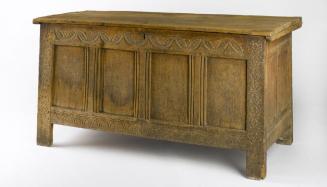Door
MakerMade by
Unknown
Date1650-1700
MediumPine, iron hardware
DimensionsPrimary Dimensions (overall height x width x depth): 78 1/4 x 38 1/2 x 1 3/4in. (198.8 x 97.8 x 4.4cm)
ClassificationsArchitectural Elements
Credit LineMuseum purchase
Object number1983.32.0
DescriptionPine door in the seventeenth century style. The door is formed of panel-and-frame construction, consisting of vertical stiles and horizontal rails that frame nine, plain, recessed panels. The door has two, full-height, vertical stiles, one at each side of the door. Between these are four horizontal rails, one at the top and bottom, and two evenly-spaced between. Between each horizontal rail are two vertical, evenly-spaced stiles. Each side, vertical stile has a center row consisting of large, tapered, gouged, half circles flanked by a row of small, gouged, half circles, a fillet, and a row of small, gouged, tapered half circles. Each center horizontal rail and vertical stile has a center row of off-set, gouged, quarter circles that form a two-lobed pinwheel, flanked by a fillet and a row of small, tapered, gouged, half circles. Additional incised lines and punched points, perhaps made with a compass, decorate the center row of gouged decoration on all the stiles. The edge of the vertical stiles and horizontal rails that frame the recessed panels are canted. The door has an overall light brown paint finish. There are two iron butterfly hinges on the left side of the door. There is one keyhole carved out of the wood on the right side of the door; an iron locking mechanism is located behind the keyhole, on the opposite side of the door. Above the keyhole are three, carved rectangular holes in the wood.
Condition: A lengthy splinter of wood is partially separated from the right side of the right vertical stile, above the keyhole; the split is growing. The painted surface has worn in some areas. Half of the top butterfly hinge is missing. The locking mechanism is replaced.
Construction Details: The door is formed of panel-and-frame construction. The panels are joined with a tongue-in-groove to the rails and stiles. The rails are joined to the stiles at each corner with a mortise-and-tenon joint that is secured with a pair of wooden pins. The door was carved after it was assembled. The back of the door is plain; the panels have canted edges but the rails and stiles are uncarved. The hinges are joined to the door with wrought iron nails.
Condition: A lengthy splinter of wood is partially separated from the right side of the right vertical stile, above the keyhole; the split is growing. The painted surface has worn in some areas. Half of the top butterfly hinge is missing. The locking mechanism is replaced.
Construction Details: The door is formed of panel-and-frame construction. The panels are joined with a tongue-in-groove to the rails and stiles. The rails are joined to the stiles at each corner with a mortise-and-tenon joint that is secured with a pair of wooden pins. The door was carved after it was assembled. The back of the door is plain; the panels have canted edges but the rails and stiles are uncarved. The hinges are joined to the door with wrought iron nails.
Status
Not on view











